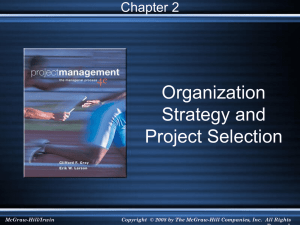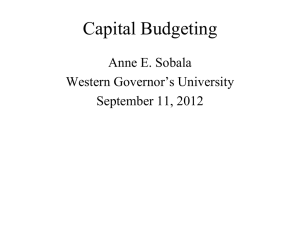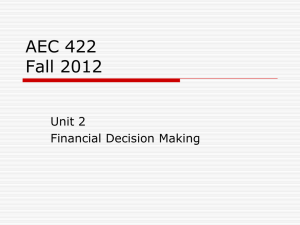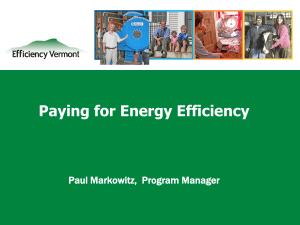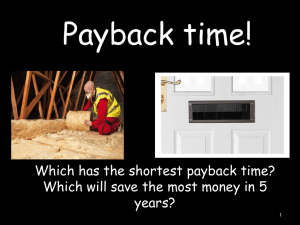learning objective
advertisement
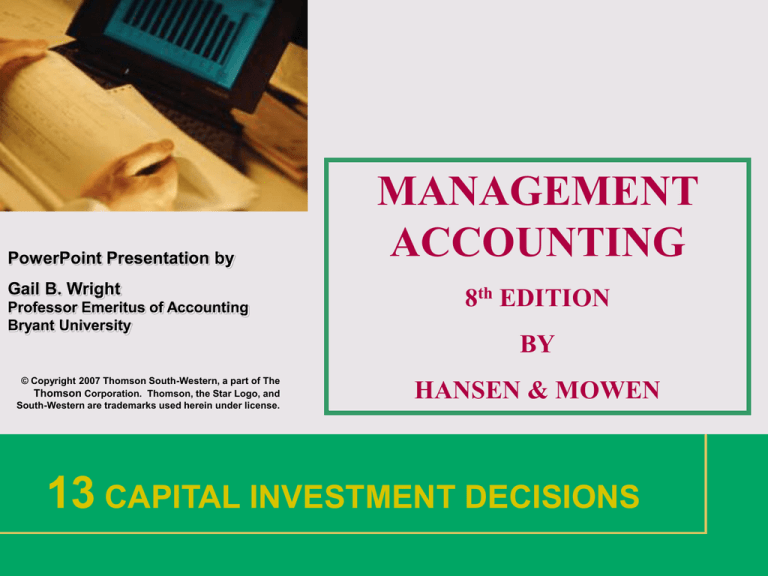
PowerPoint Presentation by Gail B. Wright Professor Emeritus of Accounting Bryant University MANAGEMENT ACCOUNTING 8th EDITION BY © Copyright 2007 Thomson South-Western, a part of The Thomson Corporation. Thomson, the Star Logo, and South-Western are trademarks used herein under license. HANSEN & MOWEN 13 CAPITAL INVESTMENT DECISIONS 1 LEARNING OBJECTIVES LEARNING GOALS After studying this chapter, you should be able to: 2 LEARNING OBJECTIVES 1. Explain what a capital investment decision is; distinguish between independent & mutually exclusive decisions. 2. Compute payback period, accounting rate of return for proposed investment; explain their roles. 3. Use net present value analysis for capital investment decision of independent projects. Continued 3 LEARNING OBJECTIVES 4. Use internal rate of return to assess acceptability of independent projects. 5. Discuss the role and value of postaudits. 6. Explain why NPV is better than IRR for capital investment decisions of mutually exclusive projects. Continued 4 LEARNING OBJECTIVES 7. Convert gross cash flows to after-tax flows. 8. Describe capital investment in advanced manufacturing environment. Click the button to skip Questions to Think About 5 QUESTIONS TO THINK ABOUT: Honley Medical What role, if any, should qualitative factors play in capital budgeting decisions? 6 QUESTIONS TO THINK ABOUT: Honley Medical How do we measure the financial benefits of long-term investments? 7 QUESTIONS TO THINK ABOUT: Honley Medical Why are cash flows important for assessing the financial merits of an investment? 8 QUESTIONS TO THINK ABOUT: Honley Medical What role doe taxes & inflation play in assessing cash flows? Should cash flows of intangible factors be estimated? 9 LEARNING OBJECTIVE 1 Explain what a capital investment decision is; distinguish between independent & mutually exclusive decisions. 10 LO 1 CAPITAL INVESTMENT DECISIONS: Definition Are concerned with the process of planning, setting goals & priorities, arranging financing, & using certain criteria to select long–term assets. 11 LO 1 How do the 2 types of capital budgeting differ? In capital budgeting, decisions to accept/reject an independent project does not affect decisions about another project whereas acceptance of a mutually exclusive project precludes other projects. 12 LO 1 What is a “reasonable return” on a capital investment? A capital investment must earn back its original cost and cover opportunity cost of funds invested. 13 LO 1 CAPITAL INVESTMENT METHODS Methods used to guide managers’ investment decisions are: Nondiscounting Payback period Accounting rate of return Discounting Net present value (NPV) Internal rate of return (IRR) 14 LEARNING OBJECTIVE 2 Compute payback period, accounting rate of return for proposed investment; explain their roles. 15 LO 2 PAYBACK PERIOD: Definition Is the time required for a firm to recover its original investment. 16 LO 2 HONLEY MEDICAL: Background Honley Medical invests $1,000,000 in a new RV generator. The investment is expected to generate net cash flows of $500,000 per year. How long will it take for the project to break even? 17 LO 2 FORMULA: Payback Period Payback period tells how long it will take a project to break even. Payback period = Original investment ÷ Annual cash flows = $1,000,000 / $500,000 = 2 years 18 LO 2 PAYBACK PERIOD: Uses Sets maximum payback period for all projects; rejects any that exceed payback period Measures of risk Riskier firms use shorter payback period In liquidity problems, use shorter payback period Avoids obsolescence 19 LO 2 PAYBACK PERIOD: Deficiencies Ignores performance of investment beyond payback period Ignores time value of money 20 LO 2 HONLEY MEDICAL: Background Honley Medical is choosing between 2 different types of computer-aided design systems (CAD). Each system requires a $150,000 initial outlay and has a 5-year life. Will using payback period help make the right choice? 21 LO 2 CAD DECISION Payback period Investment CAD – A CAD - B Year 1 Year 2 Year 3 Year 4 Year 5 $ 90,000 $ 60,000 $ 50,000 $ 50,000 $ 50,000 40,000 110,000 25,000 25,000 25,000 } Payback period does not distinguish between the 2 investments because the payback periods are equal but the return after payback is different. 22 LO 2 PAYBACK PERIOD: Summary Payback period provides information that can be used to help Control risks of uncertain future cash flows Minimize impact of investment on liquidity problems Control risk of obsolescence Control effects of investment on performance measures 23 LO 2 HONLEY MEDICAL: Background Honley Medical’s IV Division is considering investing in a special tooling with a 5 year life that requires an initial outlay of $100,000. Average cash flow is $36,000 & depreciation is $20,000. Will the investment earn an acceptable accounting rate of return? 24 LO 2 FORMULA: Accounting Rate of Return Accounting rate of return is a nondiscounting model of return on a project. Accounting rate of return = Average income ÷ Original investment (or Average investment) = ($36,000 - $20,000) / $100,000 = 16% or = ($36,000 - $20,000) / $50,000 = 32% 25 LO 2 What are similarities and differences between payback period & accounting rate of return? Payback period & accounting rate of return are similar because they ignore time value of money but different because accounting rate of return considers profitability. 26 LEARNING OBJECTIVE 3 Use net present value analysis for capital investment decision of independent projects. 27 LO 3 NET PRESENT VALUE (NPV): Definition Is the difference between the present value of the cash inflows & outflows associated with a project. 28 LO 3 NPV: What You Need to Know Present value of project’s cost Cash inflow to be received in each period Useful life of project Required rate of return (hurdle rate) Time period Present value of project’s future cash inflows Discount factor 29 LO 3 ANALYZING NPV When NPV is positive: The initial investment has been recovered The required rate of return has been achieved A return in excess of (1) & (2) has been received 30 LO 3 HONLEY MEDICAL: Background Honley Medical is considering producing a home blood pressure instrument. Equipment costing $320,000 plus $40,000 increase in working capital would be required for the project. Annual net cash flows of $120,000 are expected and Honley requires a 12% rate of return. Should Honley produce the new product? 31 LO 3 CASH FLOW: Step 1 The first step in calculating the NPV is to determine the total cash flows of the project. EXHIBIT 13.2 32 LO 3 CASH FLOW: Step 2 The second step is to calculate the present value of the annual cash flows. EXHIBIT 13.2 33 LEARNING OBJECTIVE 4 Use internal rate of return to assess acceptability of independent projects. 34 LO 4 INTERNAL RATE OF RETURN (IRR): Definition Is the interest rate that sets the present value of a project’s cash inflows equal to the present value of a project’s cost. 35 LO 4 HONLEY MEDICAL: Background Honley Medical is considering investing $1,200,000 in a new ultrasound system product. Net annual cash inflows of $499,500 will occur for 3 years. Should Honley invest in the new product? 36 LO 4 FORMULA: IRR IRR measures a project’s rate of return against a hurdle rate for accepting projects. IRR = Investment ÷ Annual cash flows = $1,200,000 / $499,500 = 2.402 (12%) 37 LO 4 Can IRR be calculated if the cash flows are uneven? Yes. But you must use trial & error, a business calculator, or a spreadsheet. 38 LEARNING OBJECTIVE 5 Discuss the role and value of postaudits. 39 LO 5 POSTAUDIT: Definition Compares actual benefits to estimated benefits & actual operating costs to estimated operating costs. 40 LO 5 What happens as a result of a postaudit? Evaluation may conclude the investment worked as expected or might propose corrective action. 41 LO 5 POSTAUDIT RESULTS In the case of Honley Medical’s investment in RF, the postaudit concluded that the investment was a poor decision. Benefits: Complaints decreased Fewer rejections Direct labor & materials costs decreased Costs: Investment & operating costs higher Costs outweighed benefits 42 LO 5 POSTAUDIT Cost-Benefit Analysis Benefits Ensures resources are used wisely Additional funds for profitable projects Corrective action when needed Impacts managerial behavior Managers held accountable for decisions Decisions made in best interest of firm Costs Costly Operating environment different from original assumptions 43 LEARNING OBJECTIVE 6 Explain why NPV is better than IRR for capital investment decisions of mutually exclusive projects. 44 LO 6 COMPARING NPV & IRR Similarities NPV & IRR yield same decision for independent projects Differences Cash inflows: NPV assumes reinvested at same rate but IRR assumes reinvested at IRR rate NPV measures profitability in absolute terms but IRR measures in relative terms Choosing projects: NPV consistent with maximizing shareholder wealth while IRR does not always provide results that will maximize wealth 45 LO 6 SELECTING BEST PROJECTS Selection process Assess cash flow pattern for each project Compute NPV for each project Identify project with greatest NPV 46 LO 6 HONLEY MEDICAL: Background Honley Medical is choosing between 2 different processes to prevent production of contaminants. Design A requires initial outlay of $180,000 while Design B requires an initial outlay of $210,000. Honley Medical has a 12% cost of capital. Which process should be selected? 47 LO 6 POLUTION CONTROL Investment Annual revenues Annual operating costs Equipment (before Y1) Project life Design A Design B $179,460 $239,280 119,460 169,280 180,000 210,000 5 years 5 years While both projects offer a 20% return evaluated by IRR, Design B offers a NPV of $42,350 while Design A offers a NPV of $36,300. 48 LO 6 CASH FLOW PATTERNS: Panel A Cash flow patterns are even but different as are investment costs. EXHIBIT 13.3 49 LO 6 IRR ANALYSIS: Panel B IRR produces same result for both designs. EXHIBIT 13.3 Design A Design B 50 LO 6 NPV ANALYSIS: Panel C EXHIBIT 13.3 Design A NPV shows that Design B is best. Design B 51 LEARNING OBJECTIVE 7 Convert gross cash flows to after-tax flows. 52 LO 7 COMPUTING CASH FLOWS To compute project cash flows, First forecast revenues, expenses, & capital outlays Then adjust gross cash flows for inflation & tax effects 53 LO 7 CASH FLOWS & INFLATION The project will not be accepted unless an inflation adjustment is done. EXHIBIT 13-4 54 LO 7 FORMULA: After-Tax Cash Flows After-tax cash flows help evaluate project acceptability. After-tax cash flows = After-tax net income + Noncash expenses = $90,000 + $200,000 = $290,000 55 LEARNING OBJECTIVE 8 Describe capital investment in advanced manufacturing environment. 56 LO 8 Is financial information the only information used to set criteria for project evaluation? NO. Both financial and nonfinancial information are used to set criteria in an advanced manufacturing environment. 57 CHAPTER 13 THE END 58


